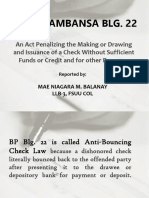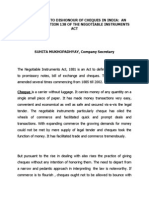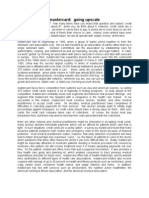0 ratings0% found this document useful (0 votes)
80 viewsCheque Dishonour
Cheque Dishonour
Uploaded by
riaduzzaman1A cheque is a negotiable instrument drawn on a bank to pay a certain amount to the bearer on demand. A cheque is dishonored when it is presented for payment within 6 months but the bank refuses payment due to insufficient funds or instructions to stop payment. Common reasons for dishonour include insufficient funds, stop payment instructions, signature mismatch, discrepancies in amounts written in words and figures. If a cheque is dishonored, the holder must issue a legal notice within 30 days and can file a complaint after 30 days if the amount is not paid. If convicted, punishment may include imprisonment up to 1 year and/or a fine up to 3 times the cheque amount. Key documents needed for the legal process include the
Copyright:
© All Rights Reserved
Available Formats
Download as PPTX, PDF, TXT or read online from Scribd
Cheque Dishonour
Cheque Dishonour
Uploaded by
riaduzzaman10 ratings0% found this document useful (0 votes)
80 views8 pagesA cheque is a negotiable instrument drawn on a bank to pay a certain amount to the bearer on demand. A cheque is dishonored when it is presented for payment within 6 months but the bank refuses payment due to insufficient funds or instructions to stop payment. Common reasons for dishonour include insufficient funds, stop payment instructions, signature mismatch, discrepancies in amounts written in words and figures. If a cheque is dishonored, the holder must issue a legal notice within 30 days and can file a complaint after 30 days if the amount is not paid. If convicted, punishment may include imprisonment up to 1 year and/or a fine up to 3 times the cheque amount. Key documents needed for the legal process include the
Original Description:
cheque dishonour
Original Title
cheque dishonour
Copyright
© © All Rights Reserved
Available Formats
PPTX, PDF, TXT or read online from Scribd
Share this document
Did you find this document useful?
Is this content inappropriate?
A cheque is a negotiable instrument drawn on a bank to pay a certain amount to the bearer on demand. A cheque is dishonored when it is presented for payment within 6 months but the bank refuses payment due to insufficient funds or instructions to stop payment. Common reasons for dishonour include insufficient funds, stop payment instructions, signature mismatch, discrepancies in amounts written in words and figures. If a cheque is dishonored, the holder must issue a legal notice within 30 days and can file a complaint after 30 days if the amount is not paid. If convicted, punishment may include imprisonment up to 1 year and/or a fine up to 3 times the cheque amount. Key documents needed for the legal process include the
Copyright:
© All Rights Reserved
Available Formats
Download as PPTX, PDF, TXT or read online from Scribd
Download as pptx, pdf, or txt
0 ratings0% found this document useful (0 votes)
80 views8 pagesCheque Dishonour
Cheque Dishonour
Uploaded by
riaduzzaman1A cheque is a negotiable instrument drawn on a bank to pay a certain amount to the bearer on demand. A cheque is dishonored when it is presented for payment within 6 months but the bank refuses payment due to insufficient funds or instructions to stop payment. Common reasons for dishonour include insufficient funds, stop payment instructions, signature mismatch, discrepancies in amounts written in words and figures. If a cheque is dishonored, the holder must issue a legal notice within 30 days and can file a complaint after 30 days if the amount is not paid. If convicted, punishment may include imprisonment up to 1 year and/or a fine up to 3 times the cheque amount. Key documents needed for the legal process include the
Copyright:
© All Rights Reserved
Available Formats
Download as PPTX, PDF, TXT or read online from Scribd
Download as pptx, pdf, or txt
You are on page 1of 8
What is a cheque?
Cheque defined under section 6 of The Negotiable Instrument Act, 1881. It
articulated, A “Cheque” is a bill of exchange drawn on a specified banker
and not expressed to be payable otherwise than on demand.
In simple terms, a cheque is a document that is negotiable and
exchangeable and the bank who issued the cheque is liable to pay the
amount mentioned in the cheque on demand.
What is cheque dishonour?
A cheque is said to be dishonoured when the cheque is presented before
the authorised bank within six months of the issue date of the cheque and
the amount mentioned in the cheque is not paid by the bank for any
default of the drawer of the cheque.
That means when drawee or the person who is a holder in due course get
rejected by the bank in other word dishonoured by the bank by not
providing the mentioned amount as instructed by the drawer (via cheque)
by the fault of the drawer.
Reasons for dishonour of cheque
Generally, a cheque is dishonoured when;
The amount not available in the account is not sufficient to pay the cheque or no money in the amount.
Where instruction is given to stop payment.
If the sign does not match with the sign of the drawer.
When the written amount (by words) does not match the amount mentioned in the cheque.
When the cheque is not filled up correctly.
When it is evident that the cheque is edited improperly and not confirmed by additional signature at the
place of editing.
In the mentioned situation a cheque can be dishonoured but the drawer of the cheque would only be
liable if he is responsible for any such matter or when he dishonoured the cheque with criminal
intention.
Cause of action
Cause of action means when you can start the procedure a case or suit. In
case of a cheque, a cheque must be presented before the bank within six
months from the issuance of the cheque and after that if the cheque is
dishonoured by the bank the cause of action shall initiate for the cheque
dishonour case.
If a bank dishonours the cheque ask them to provide a written document
for such dishonour. They will provide a written
document/cheque dishonour slip providing the reason for dishonour and
other details.
Punishment for cheque dishonour
An accused, if proved guilty of cheque dishonour, can be punished with
imprisonment for a term which may extend to one year, or with fine which
may extend to thrice the amount of the cheque, or with both.
The court may provide both imprisonment and fine (general practice) but
if the court wants to punish the offender only by imprisonment he can do
so. The court may provide fine up to thrice the amount of the cheque. It
solely depends on the court’s discretion.
Procedure
Issue notice
The first step to initiate a case under section 138 of the Negotiable
Instrument Act, 1881 to issue a legal notice via the registered post with AD
to the drawer and this is a must precondition. The notice must be issued
within 30 days of the dishonour of the cheque; informing the drawer that
his cheque has been dishonoured by his bank and he must pay the amount
in full within 30 days of the notice otherwise you will take legal action.
The payee or the holder in due course of the cheque can file a complaint
case after the compilation of 30 days or notice, if the drawer does not
provide the money within 30 days after receiving the notice or does not
reply or where replied to legal notice but did not provide any satisfactory
answer to the notice provided.
Documents needed to issue notice and initiate a case
Following documents and information would be necessary to issue a
notice and initiate a cause under section 138 or section 140 of the
Negotiable Instrument Act, 1881.
The cheque
Issue date of the cheque and rejection date of the cheque
cheque dishonour document provided by the bank
Copy of the notice and reply of that notice (if provided)
Receipt of acknowledgement of the notice
Why the cheque was provided or reason behind the transaction
Details of the cheque
Details of the complainant
You might also like
- Your Business Advantage Checking Bus Platinum Privileges: Account SummaryDocument6 pagesYour Business Advantage Checking Bus Platinum Privileges: Account SummaryN N100% (1)
- Onboarding Presentation - 07-03-2023 - 230311 - 182952 PDFDocument26 pagesOnboarding Presentation - 07-03-2023 - 230311 - 182952 PDFHavana Ravaliarison100% (2)
- New Nri Poa For IdbiDocument3 pagesNew Nri Poa For Idbihameed05100% (1)
- The 5 Elements of the Highly Effective Debt Collector: How to Become a Top Performing Debt Collector in Less Than 30 Days!!! the Powerful Training System for Developing Efficient, Effective & Top Performing Debt CollectorsFrom EverandThe 5 Elements of the Highly Effective Debt Collector: How to Become a Top Performing Debt Collector in Less Than 30 Days!!! the Powerful Training System for Developing Efficient, Effective & Top Performing Debt CollectorsRating: 5 out of 5 stars5/5 (1)
- Bp-22 and PD 1689Document64 pagesBp-22 and PD 1689Mae Niagara100% (1)
- Dishonour of Cheques in India: A Guide along with Model Drafts of Notices and ComplaintFrom EverandDishonour of Cheques in India: A Guide along with Model Drafts of Notices and ComplaintRating: 4 out of 5 stars4/5 (1)
- Upload An Approved Document, You Will Be Able To Download The DocumentDocument25 pagesUpload An Approved Document, You Will Be Able To Download The Documentdaniel18ctNo ratings yet
- A Field Report On Rastriya Banijya BankDocument33 pagesA Field Report On Rastriya Banijya BankPrashant Pokharel69% (16)
- Cheque Dishonour Case Under Negotiable Instrument ActDocument7 pagesCheque Dishonour Case Under Negotiable Instrument Actriaduzzaman1No ratings yet
- Dishonour of ChequeDocument4 pagesDishonour of ChequeRaj Kumar100% (1)
- Remedies For Dishonour of ChequeDocument3 pagesRemedies For Dishonour of ChequeManasvi JoshiNo ratings yet
- Notice Under Negotiable Instruments Act Regarding Dishonour ChequeDocument7 pagesNotice Under Negotiable Instruments Act Regarding Dishonour ChequeShashank DashNo ratings yet
- Section 138 ProcedureDocument7 pagesSection 138 Proceduresiddhantrai2011No ratings yet
- Ni Act Sec 138Document2 pagesNi Act Sec 138dinar aimcNo ratings yet
- Dishonour of ChequeDocument26 pagesDishonour of ChequeAnkit Tiwari0% (1)
- DollyDocument21 pagesDollymahendra pawarNo ratings yet
- About Cheque Bounced Legla NoticeDocument3 pagesAbout Cheque Bounced Legla Noticedandasi.chandraiahNo ratings yet
- Losc Assignment Sanjna Padmam 1701Document3 pagesLosc Assignment Sanjna Padmam 1701sanjna padmamNo ratings yet
- Cheque BounceDocument5 pagesCheque BounceLucky VinnakotaNo ratings yet
- Assignment of Banking LawDocument9 pagesAssignment of Banking LawHarish KeluskarNo ratings yet
- Study Circles PDFDocument42 pagesStudy Circles PDFHussain100% (1)
- Dishonour of ChequeDocument6 pagesDishonour of ChequeRoshan Luke MathiasNo ratings yet
- Cheque BounceDocument2 pagesCheque BounceShivangi PorwalNo ratings yet
- Acknowledgement: Asraf Uddin, Lecturer, Department of Law, Leading UniversityDocument7 pagesAcknowledgement: Asraf Uddin, Lecturer, Department of Law, Leading UniversityMazharul islamNo ratings yet
- Banking Law Final DraftDocument13 pagesBanking Law Final DraftAkash JainNo ratings yet
- Cheque Bounce ProcedureDocument14 pagesCheque Bounce ProcedureChethan M GowdaNo ratings yet
- RecentTrends 84090Document11 pagesRecentTrends 84090naytik jainNo ratings yet
- Cheque Dishonor Court Cases Sec 14Document33 pagesCheque Dishonor Court Cases Sec 14Sulav DulalNo ratings yet
- Bouncing CheckDocument3 pagesBouncing CheckginalynNo ratings yet
- Problems On Negotiable - Instrument - Act PDFDocument11 pagesProblems On Negotiable - Instrument - Act PDFShanu Bijnor67% (3)
- Banking Law - Law Relating To Dishonour of Cheques in India: An Analysis of Section 138 of The Negotiable Instruments ActDocument37 pagesBanking Law - Law Relating To Dishonour of Cheques in India: An Analysis of Section 138 of The Negotiable Instruments ActKashyap Kumar NaikNo ratings yet
- Section 138 of The Negotiable Instruments Act - 220510 - 222824Document2 pagesSection 138 of The Negotiable Instruments Act - 220510 - 222824Priya Gupta0% (1)
- Section 138 NIDocument19 pagesSection 138 NIharshNo ratings yet
- Parteek Business Law 8Th Sem PDFDocument12 pagesParteek Business Law 8Th Sem PDFparteekkhera2002No ratings yet
- Liability For Dishonor of Cheques ProjectDocument25 pagesLiability For Dishonor of Cheques ProjectAbhijeet TalwarNo ratings yet
- Cheque BouncingDocument3 pagesCheque BouncingAnjli Sampat100% (1)
- Bouncing of Check-Company Law Class PresentationDocument10 pagesBouncing of Check-Company Law Class PresentationmayankNo ratings yet
- Bouncing CheckDocument4 pagesBouncing CheckBenitez GheroldNo ratings yet
- Dishonour of ChequesDocument15 pagesDishonour of Chequesabose06No ratings yet
- Regulatory Laws OdtDocument35 pagesRegulatory Laws Odtsharma kushaNo ratings yet
- Estafa or BP 22Document2 pagesEstafa or BP 22Anonymous MikI28PkJcNo ratings yet
- Whether A Person Get Arrested For A Cheque Bounce in IndiaDocument1 pageWhether A Person Get Arrested For A Cheque Bounce in IndiaDavesh KalsiNo ratings yet
- Dishonour of Negotiable InstrumentsDocument6 pagesDishonour of Negotiable InstrumentsMukul BajajNo ratings yet
- Banking Project AntrikshDocument14 pagesBanking Project AntrikshAntriksh yadavNo ratings yet
- Dishonour of Cheques (2) FinalestDocument36 pagesDishonour of Cheques (2) Finalestdev mhaispurkarNo ratings yet
- Legal Remedies For Dishonour of Cheque - Law Times JournalDocument5 pagesLegal Remedies For Dishonour of Cheque - Law Times JournalSajal SahaNo ratings yet
- Collecting BankerDocument16 pagesCollecting Bankeranusaya1988100% (2)
- NI Act BookDocument9 pagesNI Act Booksameerscribd31No ratings yet
- Banking Law Assigment UL18BB007Document9 pagesBanking Law Assigment UL18BB007Sanket SwaroopNo ratings yet
- How To Deal With Dishonoured Cheques in Pakistan 1728748485Document5 pagesHow To Deal With Dishonoured Cheques in Pakistan 1728748485Nasir MengalNo ratings yet
- Banking Law 1Document21 pagesBanking Law 1MAYANK GUPTANo ratings yet
- ChequeDocument15 pagesChequesagarg94gmailcomNo ratings yet
- BP 22 Nego NotesDocument5 pagesBP 22 Nego NotesAnna Lesava100% (2)
- Liability of Dishonour of ChequeDocument26 pagesLiability of Dishonour of ChequeRICHA SINGH0% (1)
- Negotiable Instruments ModifiedDocument14 pagesNegotiable Instruments ModifiedPayal AggarwalNo ratings yet
- Collecting BankerDocument15 pagesCollecting Bankeranusaya1988100% (2)
- Bouncing ChecksDocument2 pagesBouncing Checkshakdog ka baNo ratings yet
- CHEQUESDocument3 pagesCHEQUESAmbrose YollahNo ratings yet
- Bouncing Checks LawDocument9 pagesBouncing Checks Lawestrellacherilyn1995No ratings yet
- Suit Under NI Act.Document3 pagesSuit Under NI Act.Jabed HabibNo ratings yet
- Banking Project-Section 138 Negotiable Instruments ActDocument10 pagesBanking Project-Section 138 Negotiable Instruments ActSrinjoy BhattacharyaNo ratings yet
- Section 138 NIDocument19 pagesSection 138 NINagmani Kumar100% (1)
- Section 138 Negotiable Instruments ActDocument4 pagesSection 138 Negotiable Instruments ActRupesh SharmaNo ratings yet
- Metropolitan Trial Court: Counter-AffidavitDocument9 pagesMetropolitan Trial Court: Counter-AffidavitthebeautyinsideNo ratings yet
- Introduction to Negotiable Instruments: As per Indian LawsFrom EverandIntroduction to Negotiable Instruments: As per Indian LawsRating: 5 out of 5 stars5/5 (1)
- Finmar NotesDocument5 pagesFinmar NotesariannejonesmNo ratings yet
- Villafane-Neriz v. FDIC, 1st Cir. (1994)Document24 pagesVillafane-Neriz v. FDIC, 1st Cir. (1994)Scribd Government DocsNo ratings yet
- Passion Reborn": Internship Report On Bank of PunjabDocument99 pagesPassion Reborn": Internship Report On Bank of PunjabAleena Shah100% (1)
- Financial Institutions in India and There Role in Providing Institutional FinanceDocument34 pagesFinancial Institutions in India and There Role in Providing Institutional FinanceSwapnil KharadeNo ratings yet
- PBI - Unit 3-Loans and AdvancesDocument59 pagesPBI - Unit 3-Loans and AdvancesAmit PatelNo ratings yet
- Elements of Banking & InsuranceDocument77 pagesElements of Banking & InsuranceMADHULIKAANo ratings yet
- 2019 RaafDocument2 pages2019 Raafvexyl caneteNo ratings yet
- 223 176PRYee ChangDocument1 page223 176PRYee Changyeec456No ratings yet
- Crash Course: Schools BriefDocument2 pagesCrash Course: Schools BriefJoaquim MorenoNo ratings yet
- Summary MKI Chapter 4Document4 pagesSummary MKI Chapter 4DeviNo ratings yet
- Compensation ReportDocument49 pagesCompensation ReportTech InfoNo ratings yet
- 2 Master Card STPDocument3 pages2 Master Card STPapi-3719687No ratings yet
- Business Document (Acc)Document21 pagesBusiness Document (Acc)Aaradhana AnnaduraiNo ratings yet
- Banco de Oro Online BankingDocument1 pageBanco de Oro Online BankingCartagena JayNo ratings yet
- Hazir Mango Performa Invoice FarhanDocument1 pageHazir Mango Performa Invoice FarhanFarhan SheikhNo ratings yet
- ACI Practice TestDocument33 pagesACI Practice TestAbdulqadir UmarNo ratings yet
- Chapter2 PDFDocument9 pagesChapter2 PDFnurulkhairunnajahNo ratings yet
- Conceptual Framework and Accounting Standards: Quiz 02 Instructor: J. CayetanoDocument7 pagesConceptual Framework and Accounting Standards: Quiz 02 Instructor: J. CayetanoJerelyn DaneNo ratings yet
- Personal Bank Statment - 1Document2 pagesPersonal Bank Statment - 1rekew43814No ratings yet
- WC - Merits and DemeritsDocument23 pagesWC - Merits and DemeritsARUN100% (1)
- Ashu Yadav CV33 (1) - New - Docx-Converted (1) - RemovedDocument4 pagesAshu Yadav CV33 (1) - New - Docx-Converted (1) - RemovedAshuNo ratings yet
- Job Card - EnquiryDocument13 pagesJob Card - EnquiryGodsonNo ratings yet
- Detailed StatementDocument5 pagesDetailed StatementSantosh Kumar GuptaNo ratings yet
- Account StatementDocument21 pagesAccount Statement5rympjb4wjNo ratings yet
- Form A2 PDFDocument3 pagesForm A2 PDFGaurav KapoorNo ratings yet

























































































